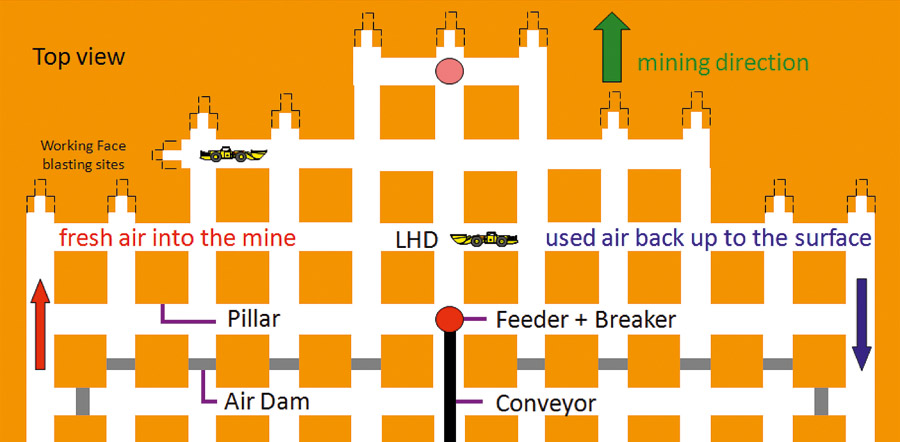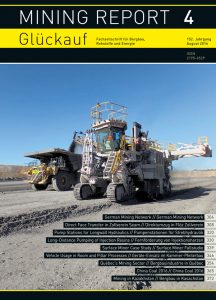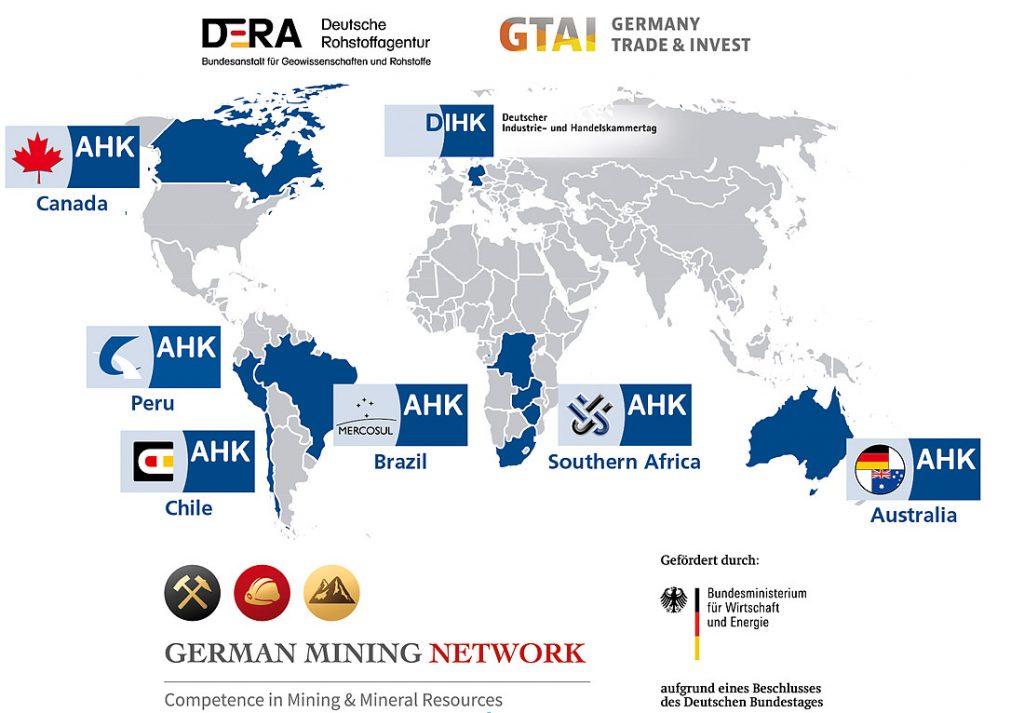German mining technology enjoys a strong international reputation, a fact borne out by the interest that this supplier sector attracts at international conferences, exhibitions and trade fairs. This has a lot to do with the innovative capacity that German mine operators have been able to bring to bear in working hand in hand with equipment manufacturers. They in turn have relied to a large degree on the research activities of mining departments at local technical colleges and universities. This benefits both the deep mining sector and the opencast industry and applies not just to coal and potash but to ore mining too, a sector that has not had a publically recognised role in Germany for more than twenty years. One underlying reason for this innovative strength …
Read moreWith my best regards // Mit freundlichem Glückauf
Dipl.-Ing. Andreas-Peter Sitte
Chief Editor Mining Report Glückauf, Herne
The German Mining Network – International Mining and Raw Materials Expertise for German Businesses
The German Mining Network is a platform of mining and raw materials experts that comprises the German Mineral Resources Agency (DERA) in the Federal Institute for Geosciences and Raw Materials (BGR), Germany Trade and Invest (GTAI) and six international competence centres affiliated to each of the bilateral Chambers of Commerce (AHK) in Australia, Brazil, Chile, Canada, Peru and Southern Africa. The German Federal Ministry for Economic Affairs and Energy (BMWi) supports the network’s activities, while the Association of German Chambers of Commerce and Industry (DIHK) has a coordinating role (Figure 1).Authors: AHK Canada, AHK Chile, AHK Australia, AHK Southern Africa, DERA
Read morePlanning and Execution of the First Direct Face Transfer in Zollverein Seam at Prosper-Haniel Colliery
The coal deposits of the gassy Zollverein 1/2 seam at Prosper-Ha-niel colliery were developed from the Prosper Nord working district on mine level 7 (1,159 m below sea level). This comprised the three coal panels numbered 123, 121 and 124. Preliminary gas drainage was a key factor leading to the success of the panel extraction projects in Zollverein 1/2 seam. The thickness of the seam meant that a new ‘category C’ shield support system had to be procured. Following the successful extraction of panel 123 the new support installation was transferred directly into the new face sequence with the supports being transported as complete units weighing nearly 40 t a piece. This report describes the first direct face transfer from panel 123 to the next panel in the sequence, number 121, an operation that was completed on schedule. The planning work, operating parameters and underlying conditions associated with this operation are all described in detail.Authors: Dipl.-Ing. Guido Heinz, Projektkoordinator im Servicebereich Technik- und Logistikdienste der RAG Aktiengesellschaft, Herne; Dipl.-Ing. Peter Fischer, Projektingenieur Abbau/Herrichten/Rauben, Dipl.-Ing. Frank Borkent, Projektingenieur Logistik und Dipl.-Ing. Thomas Rotert, Wetteringenieur, Bergwerk Prosper-Haniel der RAG Aktiengesellschaft, Herne
Read moreRecent Developments of Pump Stations for Longwall Hydraulics
Increasing lengths of longwalls, increasing support forces of shields leading to higher hydraulic pressure, bigger cylinder diameters in the roof support as well as increasing speed of extraction machines place high demands on the hydraulic supply. Modern hydraulic stations for high production longwalls provide reliably and at high availability more than 2,000 l/min emulsion at a system pressure of 350 to 420 bar for the hydraulic cylinders in the roof supports of the longwall. In addition, more and more water is used for dust suppression purposes. Pumps with an input power of up tp 500 kW per pump are already used today in high production longwalls. To manage the big flow per pump, valves with wear resistant ceramic inner parts are used. The flow of the pumps is controlled using Variable Speed Drives (VSD) and thus adapted to the demand of the longwall operation. KAMAT, worldwide leading system supplier for high pressure technology, is the driving force for further developing pump stations for longwalls.Authors: Dr.-Ing. Andreas Wahl und Dipl.-Ing. Jan Sprakel, Geschäftsführende Gesellschafter der KAMAT GmbH & Co. KG, Witten
Read moreLong-Distance Pumping of Injection Resins
The German coal industry has been using two-component resin injection as a strata reinforcement and consolidation technique for more than 30 years. Up until the early 1990s these products were mainly processed and delivered via simple pneumatic and hydraulic piston pumps, with pneumatically driven geared pumps also being employed in some cases. The resin products were supplied in disposable cans and drums. Because of increasing geomechanical stresses underground, which was a direct result of ever greater working depths and the high excavation ratio of German coal-bearing measures, it was realised that new solutions were needed for the transport and processing of synthetic resin materials, and this was ultimately to lead to the development of an effective remote pumping system. This paper will describe the various development steps that were taken to arrive at the technology currently in use today. It is based on a lecture given by the authors at the 7th Colloquium on Transport and Conveying in the Mining Industry, which was held at the Clausthal University of Technology, Clausthal-Zellerfeld, on 20th January 2016.Authors: Dipl.-Ing Ralf Schmidt und Torsten Niklaus, Servicebereich Technik- und Logistikdienste der RAG Aktiengesellschaft, Herne
Read moreSuccessful Implementation of Innovative Technology into an Existing Operation – Surface Miner Case Study
The implementation of new technology into an existing mining operation can deliver a step change in operation and commercial benefits. But it also comes along with risk. Integrating new technologies is connected to a number of challenges that could result in the rejection of the innovative technology. Detailed planning, robust project management, a good customer relationship and an evaluation of meaningful Key Performance Indicators are main aspects to manage and overcome those risks. At the New Acland Coal Mine in Queensland/Australia an innovative mining system, a Wirtgen Surface Miner, was recently adopted into the existing mining fleet. This paper aims to give an overview of the structured trial that was conducted to support the implementation of a Wirtgen 4200 SM at New Acland Coal Mine.Author: Nicole Prochnau M. Sc., Projekt Engineer at Wirtgen Australia Pty. Ltd., Acland/Australia
Read moreSimulation Based Decision Support of Vehicle Usage in Room and Pillar Processes Concerning Productivity, Outcome and Energy Consumption

Fig. 1. Room and pillar area in an underground potash and rock salt mining area (12). // Bild 1. Kammer-Pfeilerbaubereich im Kali- und Steinsalzbergbau unter Tage (12).
Authors: Dipl.-Ing. (FH) Axel Bruns, Dipl. Wirt.-Ing. Timm Kuhlmann, Fraunhofer Institute for Manufacturing Engineering and Automation (IPA), Stuttgart, Dipl.-Ing. Johann-Christoph Thiele, K+S Aktiengesellschaft, Kassel
Read moreQuébec’s Mining Sector
The Québec Government is currently working to introduce a stimulating and advantageous investment framework for the mining sector. The aim of the new Plan Nord, launched in the spring of 2015, is to develop mining, forestry, energy, social, cultural and tourist potential in the area of Québec located north of the 49th parallel, and to create jobs and wealth for all Québecers. Responsible mining development plays a primary role in this project. The Government has also launched a Strategic Vision for Mining Development for Québec that promotes mining exploration, the acquisition of geoscientific knowledge to better understand the mineral potential available in the area covered by the Plan Nord, as well as research and development on responsible mining development, to open new horizons for Québec’s mining sector.Author: Mining Sector, Ministère de l’Energie et des Ressources naturelles, Québec/Canada
Read moreChina Coal 2016: an Update
The Chinese economy has continued its downward trend in 2016. Poor sales prospects have resulted in no more than a moderate increase in investment in most sectors. As a result, the mining industry is not expected to make much of a headway this year and for those German supplier companies that have manufacturing bases in China efficiency improvement has now become a major issue. A fresh impetus in this area is expected as a result of the industrial modernisation programme ‘China 2025’.Author: Peter v. Hartlieb, Bereichsleiter Netzwerk Bergbauwirtschaft, EnergieAgentur.NRW, Düsseldorf
Read moreMining in Kazakhstan 2016
The Kazakh mining sector is gearing up for long-term expansion in the years ahead. The country remains a major supplier of raw materials to the Asian and European markets and while the price of coal, copper and iron ore could well remain weak up to 2020 this sector is still well placed to meet the future. Though Germany and Kazakhstan signed a governmental agreement in 2012 that established a partnership in raw materials, industry and technology, this has still not resulted in any significant projects. This paper describes the main raw materials now being extracted by the Kazakh mining industry and discusses the opportunities that may exist for German mining equipment suppliers.Author: Peter v. Hartlieb, Bereichsleiter Netzwerk Bergbauwirtschaft, EnergieAgentur.NRW, Düsseldorf
Read more
















